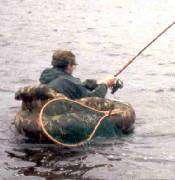Texas rig
The Texas rig is a technique used for fishing with soft plastic lures.[1] It involves a bullet-shaped [Fishing sinker|weight] being threaded onto the [fishing line] first, followed by a glass or plastic bead, and then the line is secured to a [Fish hook|hook], usually an offset worm hook.
The hook is then inserted into the head region of the worm and exits the worm about 1/4 of an inch down the worm. The worm is then moved up the hook towards the shank and then rotated so that the worm is now 'locked' on the shank. The point of the hook is then threaded back into the body of the worm to make the rig weedless.
The bead is fully optional. Some anglers find that the added noise or color a bead can provide gives them an advantage in stained or muddied water, because the clicking imitates a crayfish crawling over rocks and debris, while some anglers think that the bead detracts from a realistic presentation considering that most worms will not click.
When fishing in open water without much cover to snag on, the Texpose Rig is a better choice than a Texas Rig because it increases the number of fish you will hook. In a Texpose rig, you set it up the same way you would a Texas rig, except you push the hook point all the way through the body of the worm so it is slightly exposed. In a Texas rig, you will hook less fish than a Texpose because the hook point is not exposed, but you won't hang up like you will sometimes in a Texpose. The Texpose does not increase bites, but you will hook fish easier due to the exposed point.
The Texas Rig is not a search rig like a [spinnerbait] or a [crankbait]. It is usually fished by casting as close to cover as possible with the goal of placing the worm as close to a bass as possible. Try to let the lure enter the water with as little noise as possible and keep some controlled slack in the line as bass will commonly attack the lure while it is sinking to the bottom.
If a bass does not hit on the fall, let the worm rest on the bottom for a brief period and then begin to retrieve the lure in a very slow, jerk and pause motion. Be aware to always keep some tension on the line .Mastering this technique is a lot about learning how to differentiate between the feel of the bottom and the feel of a fish. This rig is a very effective way to catch largemouth bass in many conditions. A lighter color should be used in darker water and on darker overcast days. The darker and brighter colors in clearer water.
A general rule is to use dark colors, preferably black in anything other than super clear water as the bass can see the black form far further than colors. Even night bass fishing can be very effective using black worms.
Although bass will suck the bait off the bottom producing the familiar 'thump' feel at the rod, they may also pick it up with no indication other than the line starting to move away. Always watch the line on the fall and as it sits there. If it begins moving, figure out which way and set the hook.
With a good rod and decent mono or flurocarbon line, the 'thump' of a bass should be easily felt on limp line. After the first 'thump', wait a second to see if there is a second one as he sucks the worm in further. At this point, or if there is no second 'thump' after a second or so, draw up most of the slack and set the hook HARD AND FAST. This is important to set the hook. Then hold steady tension on the fish until landed.
Notes
- ↑ Anderson, Margie (October 30, 2008). "How To Fish A Texas Rig". Inside Line Magazine. Retrieved 2012-02-08.

